Understanding the Role of Metakaolin towards Mitigating the Shrinkage Behavior of Alkali-Activated Slag
Abstract
:1. Introduction
2. Experimental Programs
2.1. Raw Materials
2.2. Mixture Proportions and Specimen Preparation
2.3. Testing Procedure
3. Results and Discussion
3.1. Viscosity and Initial Setting Time of Alkali-Activated Slag Pastes
3.2. Compressive Strength Development of Alkali-Activated Slag Mortars
3.3. Autogenous and Drying Shrinkage of Alkali-Activated Slag Mortar
3.4. FTIR Analysis
3.5. Isothermal Adsorption/Desorption
3.6. Relationship between Drying Shrinkage and Pore Structure Characteristic of Alkali-Activated Slag
4. Conclusions
- The inclusion of metakaolin improved the initial viscosity and setting time of alkali-activated slag. However, increasing activator concentration resulted in the reduction in the initial viscosity and setting time of alkali-activated slag containing 30% metakaolin, and the initial viscosity and setting time are both increased with the increase in activator modulus from 1 to 1.5;
- The increase in metakaolin content led to the decrease in the compressive strength development of alkali-activated slag mortar. Increasing the activator concentration contributed to the improvement of the compressive strength of alkali-activated slag containing metakaolin. However, activator modulus had a less significant influence on the compressive strength;
- The autogenous and drying shrinkages of alkali-activated slag mortar were both mitigated by the inclusion of metakaolin. The increase in activator dosages and modulus both resulted in the increase in the magnitudes of the autogenous and drying shrinkage of alkali-activated slag containing 30%;
- The inclusion of metakaolin induced the decrease in reaction products and promote the formation of the reaction product with high polymerization degree. Higher activator dosage and modulus contributed to the dissolution and decomposition of metakaolin, thus facilitating the formation of the reaction products;
- The inclusion of metakaolin into alkali-activated slag and increasing the activator dosage decreased the total pore volume, but induced the coarsening of the pore structure. There was a different mechanism behind the influence of activator modulus on mitigating the time-dependent behavior of the alkali-activated slag-metakaolin binary system.
Author Contributions
Funding
Institutional Review Board Statement
Informed Consent Statement
Data Availability Statement
Conflicts of Interest
References
- Shi, C.; Qu, B.; Provis, J.L. Recent Progress in Low-Carbon Binders. Cem. Concr. Res. 2019, 122, 227–250. [Google Scholar] [CrossRef]
- Arbi, K.; Nedeljković, M.; Zuo, Y.; Ye, G. A Review on the Durability of Alkali-Activated Fly Ash/Slag Systems: Advances, Issues, and Perspectives. Ind. Eng. Chem. Res. 2016, 55, 5439–5453. [Google Scholar] [CrossRef] [Green Version]
- Provis, J.L. Alkali-Activated Materials. Cement Concr. Res. 2018, 114, 40–48. [Google Scholar] [CrossRef]
- Li, N.; Shi, C.; Zhang, Z.; Zhu, D.; Hwang, H.-J.; Zhu, Y.; Sun, T. A Mixture Proportioning Method for the Development of Performance-Based Alkali-Activated Slag-Based Concrete. Cem. Concr. Compos. 2018, 93, 163–174. [Google Scholar] [CrossRef]
- Li, N.; Shi, C.; Zhang, Z. Understanding the Roles of Activators Towards Setting and Hardening Control of Alkali-Activated Slag Cement. Compos. Part B Eng. 2019, 171, 34–45. [Google Scholar] [CrossRef]
- Li, Z.; Nedeljković, M.; Chen, B.; Ye, G. Mitigating the Autogenous Shrinkage of Alkali-Activated Slag by Metakaolin. Cem. Concr. Res. 2019, 122, 30–41. [Google Scholar] [CrossRef]
- Li, Z.; Lu, T.; Liang, X.; Dong, H.; Ye, G. Mechanisms of Autogenous Shrinkage of Alkali-Activated Slag and Fly Ash Pastes. Cem. Concr. Res. 2020, 135, 106107. [Google Scholar] [CrossRef]
- Zhang, J.; Shi, C.; Zhang, Z.; Ou, Z. Durability of Alkali-Activated Materials in Aggressive Environments: A Review on Recent Studies. Constr. Build. Mater. 2017, 152, 598–613. [Google Scholar] [CrossRef]
- Bernal, S.A.; Provis, J.L. Durability of Alkali-Activated Materials: Progress and Perspectives. J. Am. Ceram. Soc. 2014, 97, 997–1008. [Google Scholar] [CrossRef]
- Huang, L.; Liu, J.-C.; Cai, R.; Ye, H. Mechanical Degradation of Ultra-High Strength Alkali-Activated Concrete Subjected to Repeated Loading and Elevated Temperatures. Cem. Concr. Compos. 2021, 121, 104083. [Google Scholar] [CrossRef]
- Cai, R.; Ye, H. Clinkerless Ultra-High Strength Concrete Based on Alkali-Activated Slag at High Tem-Peratures. Cement Concr. Res. 2021, 145, 106465. [Google Scholar] [CrossRef]
- Nedeljković, M.; Li, Z.; Ye, G. Setting, Strength, and Autogenous Shrinkage of Alkali-Activated Fly Ash and Slag Pastes: Effect of Slag Content. Materials 2018, 11, 2121. [Google Scholar] [CrossRef] [PubMed] [Green Version]
- Li, Z.; Zhang, S.; Liang, X.; Ye, G. Cracking Potential of Alkali-Activated Slag and Fly Ash Concrete Subjected to Restrained Autogenous Shrinkage. Cem. Concr. Compos. 2020, 114, 103767. [Google Scholar] [CrossRef]
- Li, Z.; Lu, T.; Chen, Y.; Wu, B.; Ye, G. Prediction of the Autogenous Shrinkage and Microcracking of Alkali-Activated Slag and Fly Ash Concrete. Cem. Concr. Compos. 2020, 117, 103913. [Google Scholar] [CrossRef]
- Qu, Z.; Yu, Q.; Ji, Y.; Gauvin, F.; Voets, I.K. Mitigating Shrinkage of Alkali Activated Slag with Biofilm. Cem. Concr. Res. 2020, 138, 106234. [Google Scholar] [CrossRef]
- Mastali, M.; Kinnunen, P.; Dalvand, A.; Firouz, R.M.; Illikainen, M. Drying Shrinkage in Alkali-Activated Binders—A Critical Review. Constr. Build. Mater. 2018, 190, 533–550. [Google Scholar] [CrossRef]
- Li, Z.; Nedeljkovic, M.; Zuo, Y.; Ye, G. Autogenous Shrinkage of Alkali-Activated Slag-Fly Ash Pastes. In Proceedings of the 5th International Slag Valorisation Symposium, Leuven, Belgium, 3–5 April 2017; pp. 369–372. [Google Scholar]
- Jiang, D.; Li, X.; Lv, Y.; Li, C.; Jiang, W.; Liu, Z.; Xu, J.; Zhou, Y.; Dan, J. Autogenous Shrinkage and Hydration Property of Alkali Activated Slag Pastes Containing Superabsorbent Polymer. Cem. Concr. Res. 2021, 149, 106581. [Google Scholar] [CrossRef]
- Yang, J.; Snoeck, D.; De Belie, N.; Sun, Z. Comparison of Liquid Absorption-Release of Superabsor-Bent Polymers in Alkali-Activated Slag and Portland Cement Systems: An NMR Study Combined with Additional Methods. Cement Concr. Res. 2021, 142, 106369. [Google Scholar] [CrossRef]
- Hu, X.; Shi, C.; Zhang, Z.; Hu, Z. Autogenous and Drying Shrinkage of Alkali-Activated Slag Mortars. J. Am. Ceram. Soc. 2019, 102, 4963–4975. [Google Scholar] [CrossRef]
- Ye, H.; Radlińska, A. Shrinkage Mitigation Strategies in Alkali-Activated Slag. Cem. Concr. Res. 2017, 101, 131–143. [Google Scholar] [CrossRef]
- Lee, N.; Jang, J.; Lee, H. Shrinkage Characteristics of Alkali-Activated Fly Ash/Slag Paste and Mortar at Early Ages. Cem. Concr. Compos. 2014, 53, 239–248. [Google Scholar] [CrossRef]
- Zhang, L.; Yue, Y. Influence of Waste Glass Powder Usage on the Properties of Alkali-Activated Slag Mortars Based on Response Surface Methodology. Constr. Build. Mater. 2018, 181, 527–534. [Google Scholar] [CrossRef]
- Chi, M.; Huang, R. Binding Mechanism and Properties of Alkali-Activated Fly Ash/Slag Mortars. Constr. Build. Mater. 2012, 40, 291–298. [Google Scholar] [CrossRef]
- Li, N.; Shi, C.; Wang, Q.; Zhang, Z.; Ou, Z. Composition Design and Performance of Alkali-Activated Cements. Mater. Struct. 2017, 50, 178. [Google Scholar] [CrossRef]
- Ma, Y.; Ye, G. The Shrinkage of Alkali Activated Fly Ash. Cem. Concr. Res. 2015, 68, 75–82. [Google Scholar] [CrossRef]
- Pinheiro, D.D.R.; Gonçalves, L.R.; De Sena, R.L.P.; Martelli, M.C.; Neves, R.D.F.; Ribeiro, N.F.D.P. Industrial Kaolin Waste as Raw Material in the Synthesis of the SAPO-34 Molecular Sieve. Mater. Res. 2020, 23, 20200043. [Google Scholar] [CrossRef]
- Loukili, A.; Chopin, D.; Khelidj, A.; Le Touzo, J.-Y. A New Approach to Determine Autogenous Shrinkage of Mortar at an Early Age Considering Temperature History. Cem. Concr. Res. 2000, 30, 915–922. [Google Scholar] [CrossRef] [Green Version]
- JC/T 603-2004. PRC Building Materials Industry Standard: Standard Test Method for Drying Shrinkage of Mortar; Standards Press of China: Beijing, China, 2004. (In Chinese) [Google Scholar]
- Huseien, G.F.; Mirza, J.; Ismail, M.; Ghoshal, S.K.; Ariffin, M.A.M. Effect of Metakaolin Replaced Granulated Blast Furnace Slag on Fresh and Early Strength Properties of Geopolymer Mortar. Ain Shams Eng. J. 2018, 9, 1557–1566. [Google Scholar] [CrossRef] [Green Version]
- Lu, C.; Zhang, Z.; Shi, C.; Li, N.; Jiao, D.; Yuan, Q. Rheology of Alkali-Activated Materials: A Review. Cement Concr. Compos. 2021, 121, 104061. [Google Scholar] [CrossRef]
- Arnoult, M.; Perronnet, M.; Autef, A.; Rossignol, S. How to Control the Geopolymer Setting Time with the Alkaline Silicate Solution. J. Non-Cryst. Solids 2018, 495, 59–66. [Google Scholar] [CrossRef]
- Cong, X.; Zhou, W.; Geng, X.; Elchalakani, M. Low Field NMR Relaxation as a Probe to Study the Effect of Activators and Retarders on the Alkali-Activated GGBFS Setting Process. Cem. Concr. Compos. 2019, 104, 103399. [Google Scholar] [CrossRef]
- Abubakr, A.; Soliman, A.; Diab, S. Effect of Activator Nature on the Impact Behaviour of Alkali-Activated Slag Mortar. Constr. Build. Mater. 2020, 257, 119531. [Google Scholar] [CrossRef]
- Li, N.; Farzadnia, N.; Shi, C. Microstructural Changes in Alkali-Activated Slag Mortars Induced by Accelerated Carbonation. Cem. Concr. Res. 2017, 100, 214–226. [Google Scholar] [CrossRef]
- Puertas, F.; Varga, C.; Alonso, M. Rheology of Alkali-Activated Slag Pastes. Effect of the Nature and Concentration of the Activating Solution. Cem. Concr. Compos. 2014, 53, 279–288. [Google Scholar] [CrossRef]
- Ye, H.; Cartwright, C.; Rajabipour, F.; Radlińska, A. Understanding the Drying Shrinkage Perfor-Mance of Alkali-Activated Slag Mortars. Cement Concr. Compos. 2017, 76, 13–24. [Google Scholar] [CrossRef] [Green Version]
- Aydın, S.; Baradan, B. Effect of Activator Type and Content on Properties of Alkali-Activated Slag Mortars. Compos. Part B Eng. 2014, 57, 166–172. [Google Scholar] [CrossRef]
- Collins, F.; Sanjayan, J. Effect of Pore Size Distribution on Drying Shrinking of Alkali-Activated Slag Concrete. Cem. Concr. Res. 2000, 30, 1401–1406. [Google Scholar] [CrossRef]
- Yu, P.; Kirkpatrick, R.J.; Poe, B.; McMillan, P.F.; Cong, X. Structure of Calcium Silicate Hydrate (C-S-H): Near-, Mid-, and Far-Infrared Spectroscopy. J. Am. Ceram. Soc. 2004, 82, 742–748. [Google Scholar] [CrossRef]
- Wan, Q.; Rao, F.; Song, S.; García, R.E.; Estrella, R.M.; Patiño, C.A.L.; Zhang, Y. Geopolymerization Reaction, Microstructure and Simulation of Metakaolin-Based Geopolymers at Extended Si/Al Ratios. Cem. Concr. Compos. 2017, 79, 45–52. [Google Scholar] [CrossRef]
- Bernal, S.A.; Provis, J.L.; Rose, V.; Mejía de Gutierrez, R. Evolution of Binder Structure in Sodi-Um Silicate-Activated Slag-Metakaolin Blends. Cement Concr. Compos. 2011, 33, 46–54. [Google Scholar] [CrossRef]
- Brunauer, S.; Deming, L.S.; Deming, W.E.; Teller, E. On a Theory of the van der Waals Adsorption of Gases. J. Am. Chem. Soc. 1940, 62, 1723–1732. [Google Scholar] [CrossRef]
- Everett, D.H. Manual of Symbols and Terminology for Physicochemical Quantities and Units, Appendix II: Definitions, Terminology and Symbols in Colloid and Surface Chemistry. Pure Appl. Chem. 1972, 31, 577–638. [Google Scholar] [CrossRef]
- Barrett, E.P.; Joyner, L.G.; Halenda, P.P. The Determination of Pore Volume and Area Distribu-tions in Porous Substances. I. Computations from Nitrogen Isotherms. J. Am. Chem. Soc. 1951, 73, 373–380. [Google Scholar] [CrossRef]
- Provis, J.; Myers, R.; White, C.; Rose, V.; van Deventer, J.S. X-ray Microtomography Shows Pore Structure and Tortuosity in Alkali-Activated Binders. Cem. Concr. Res. 2012, 42, 855–864. [Google Scholar] [CrossRef]
- Ma, Y.; Hu, J.; Ye, G. The Pore Structure and Permeability of Alkali Activated Fly Ash. Fuel 2013, 104, 771–780. [Google Scholar] [CrossRef]
- Hansen, W. Drying Shrinkage Mechanisms in Portland Cement Paste. J. Am. Ceram. Soc. 1987, 70, 323–328. [Google Scholar] [CrossRef] [Green Version]
- Borges, P.H.R.; Banthia, N.; Alcamand, H.A.; Vasconcelos, W.; Nunes, E.H. Performance of Blended Metakaolin/Blastfurnace Slag Alkali-Activated Mortars. Cem. Concr. Compos. 2016, 71, 42–52. [Google Scholar] [CrossRef]
- Criado, M.; Fernández-Jiménez, A.; de la Torre, A.G.; Aranda, M.A.G.; Palomo, A. An XRD Study of the Effect of the SiO2/Na2O Ratio on the Alkali Activation of Fly Ash. Cem. Concr. Res. 2007, 37, 671–679. [Google Scholar] [CrossRef]
- Snoeck, D.; Velasco, L.F.; Mignon, A.; Van Vlierberghe, S.; Dubruel, P.; Lodewyckx, P.; De Belie, N. The Influence of Different Drying Techniques on the Water Sorption Properties of Cement-Based Materials. Cem. Concr. Res. 2014, 64, 54–62. [Google Scholar] [CrossRef]




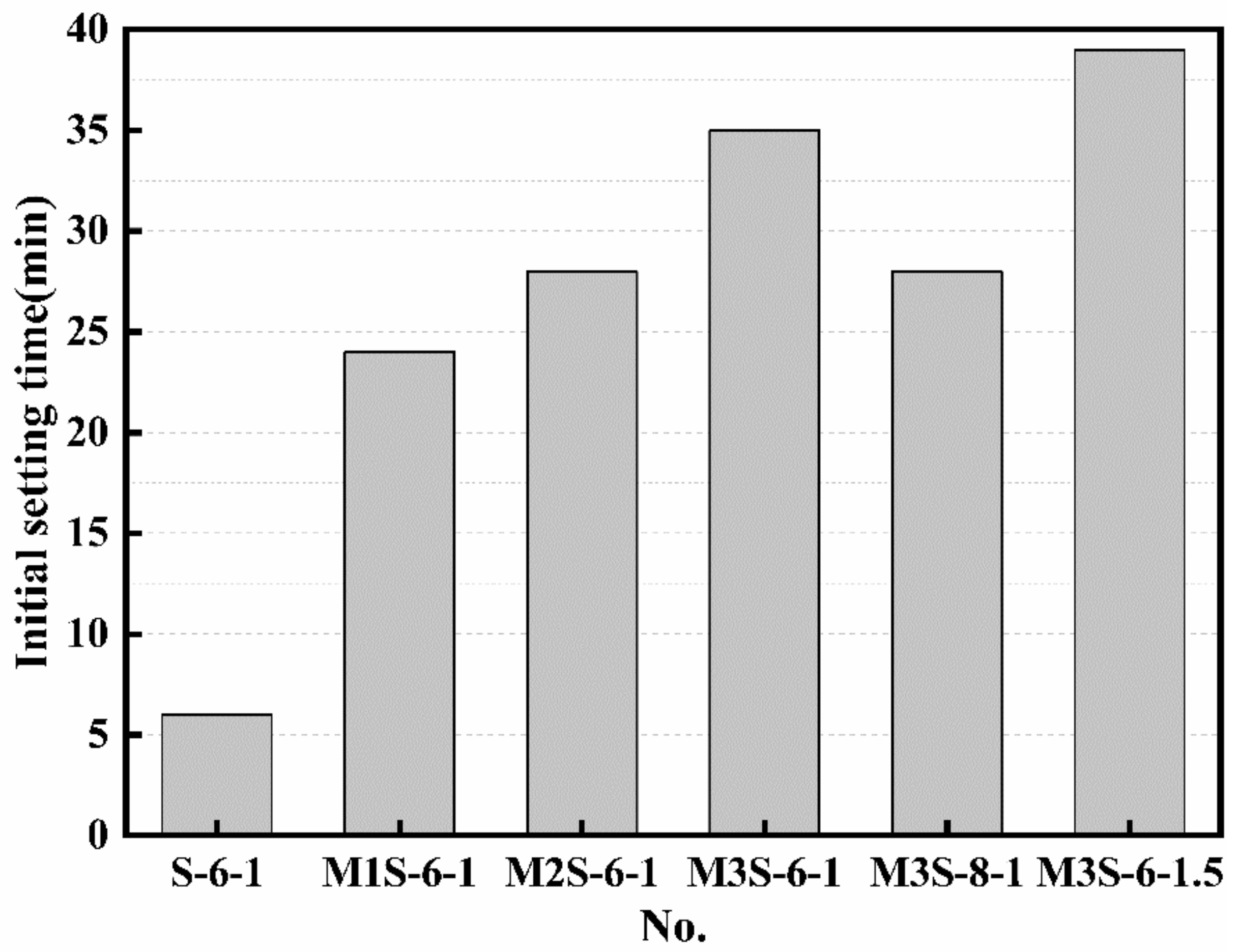
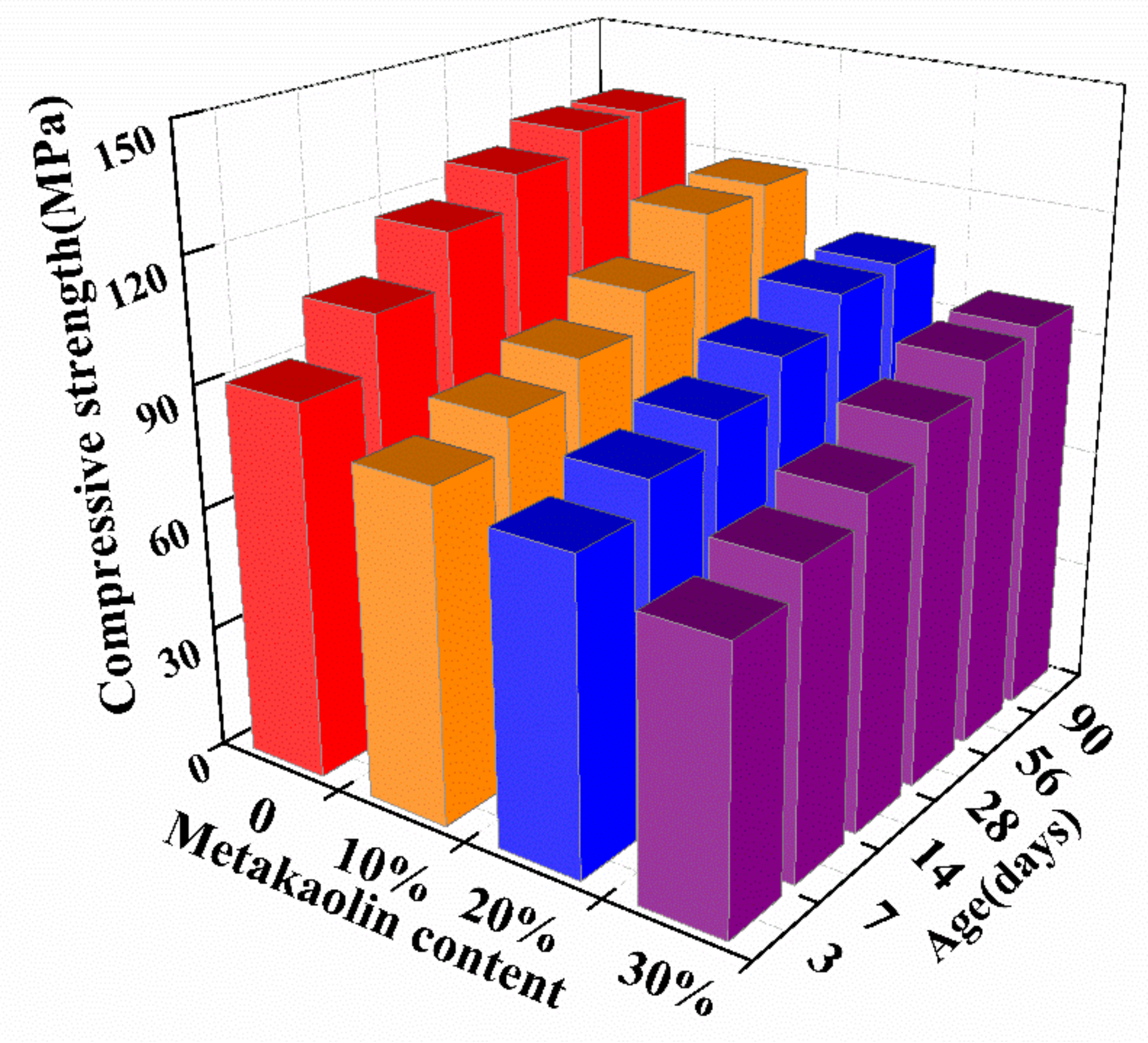
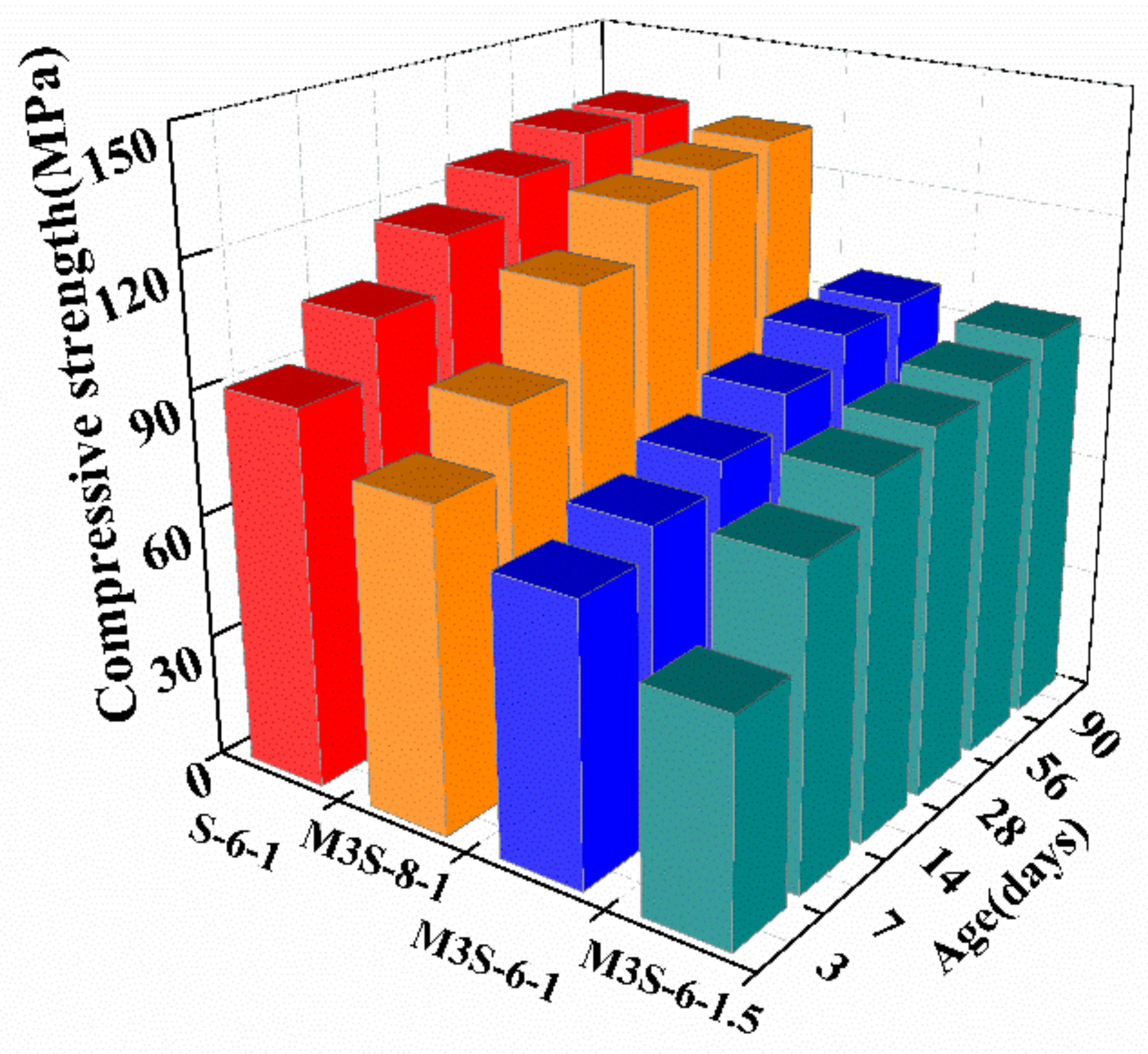


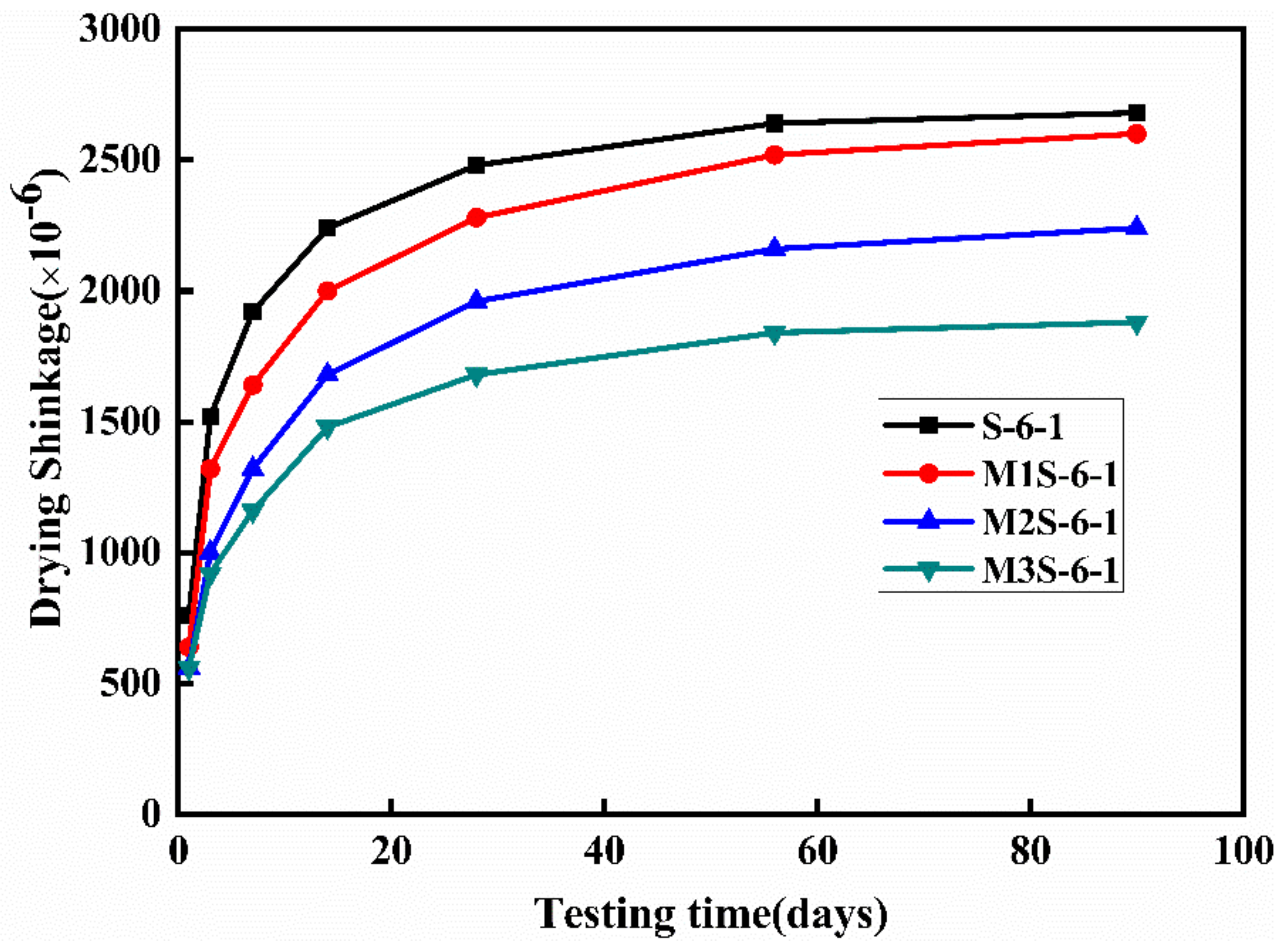
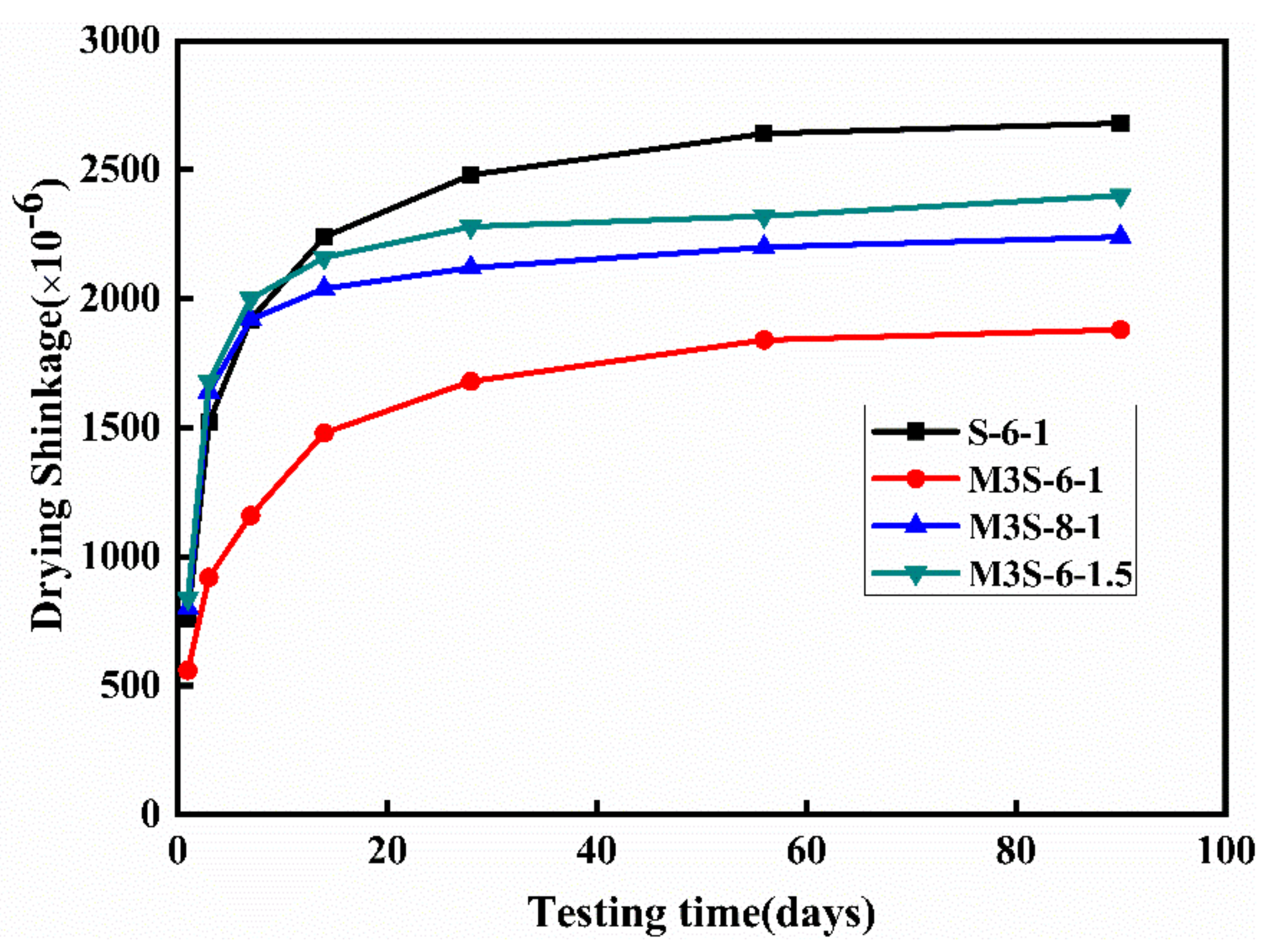
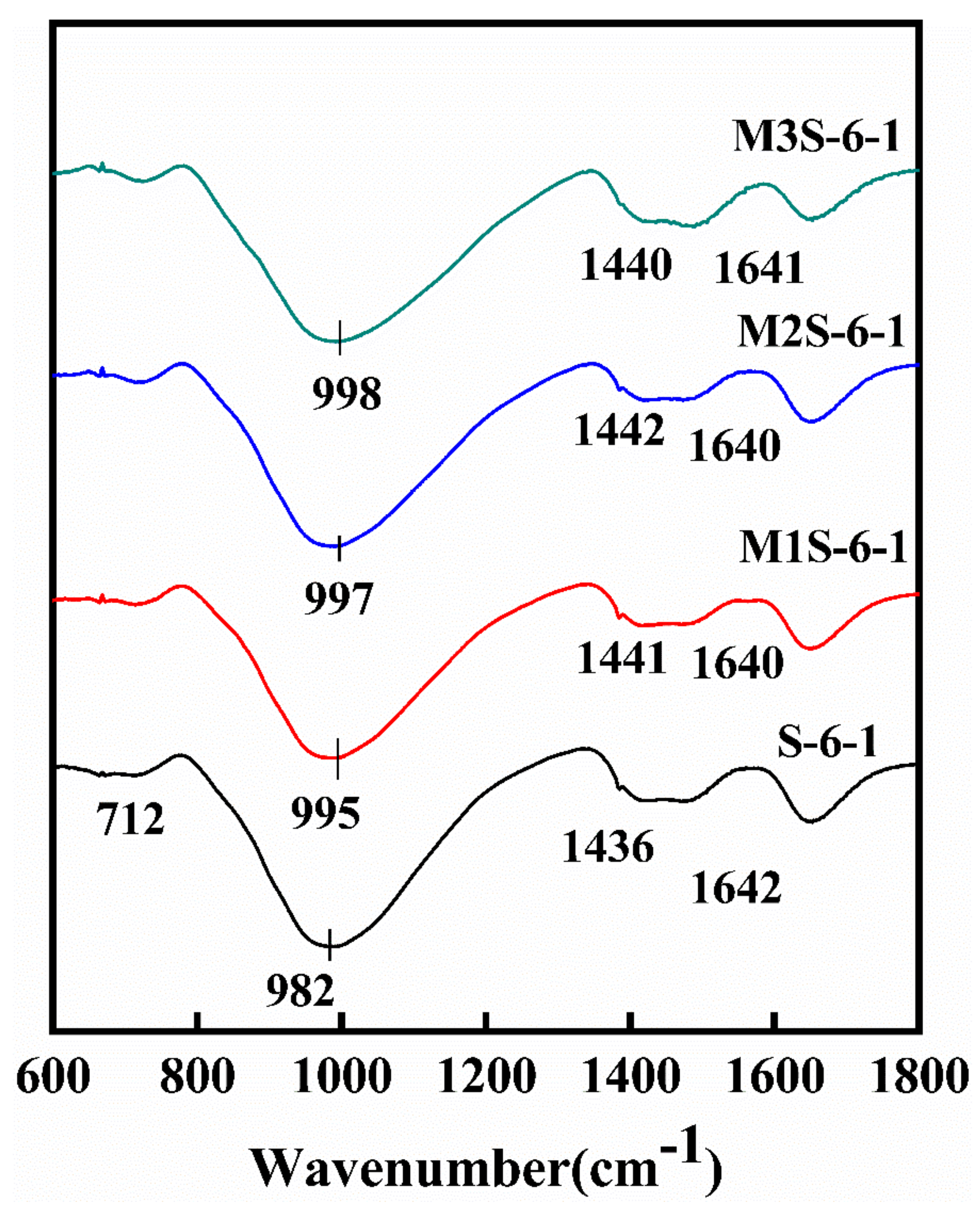

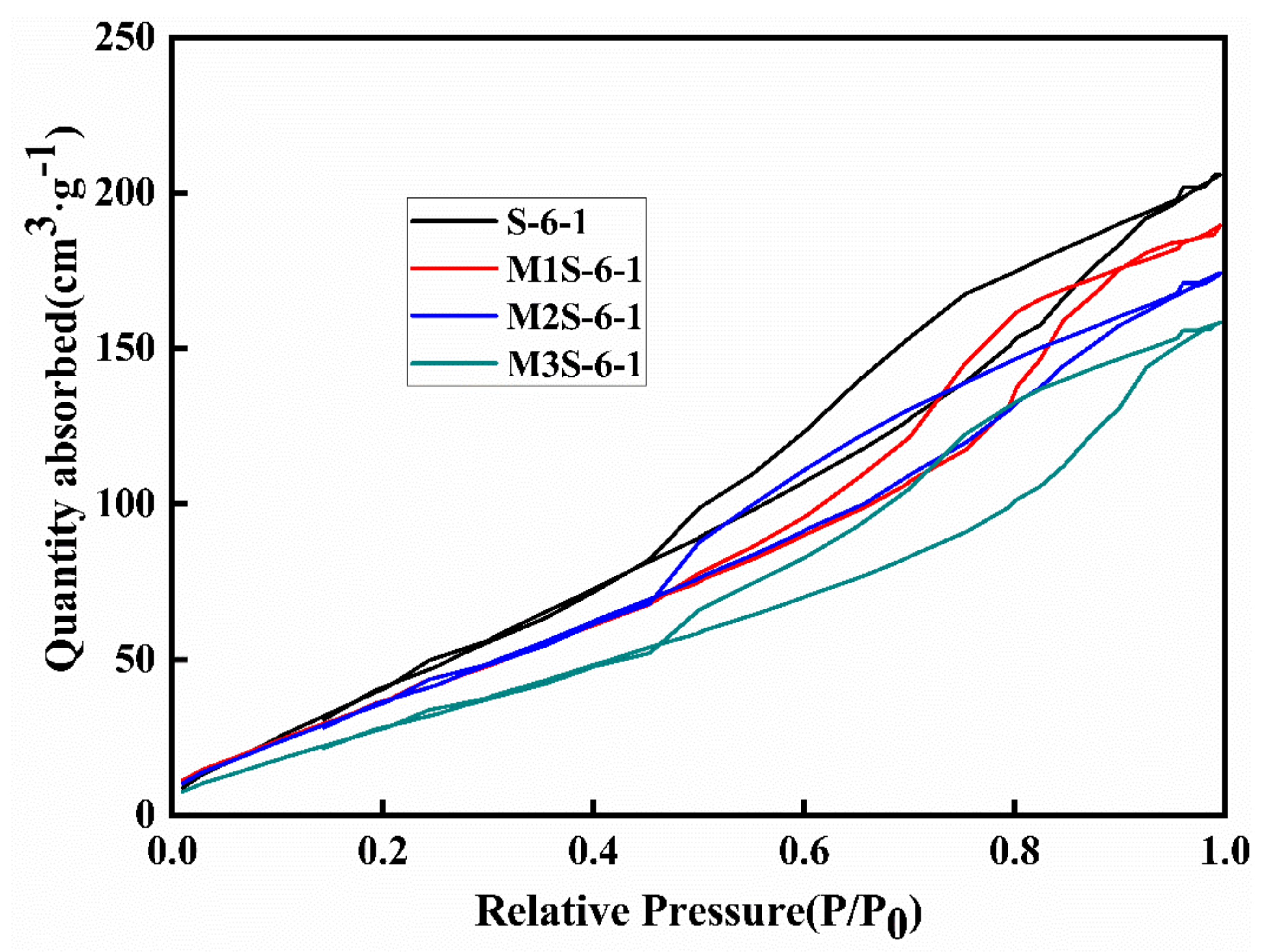
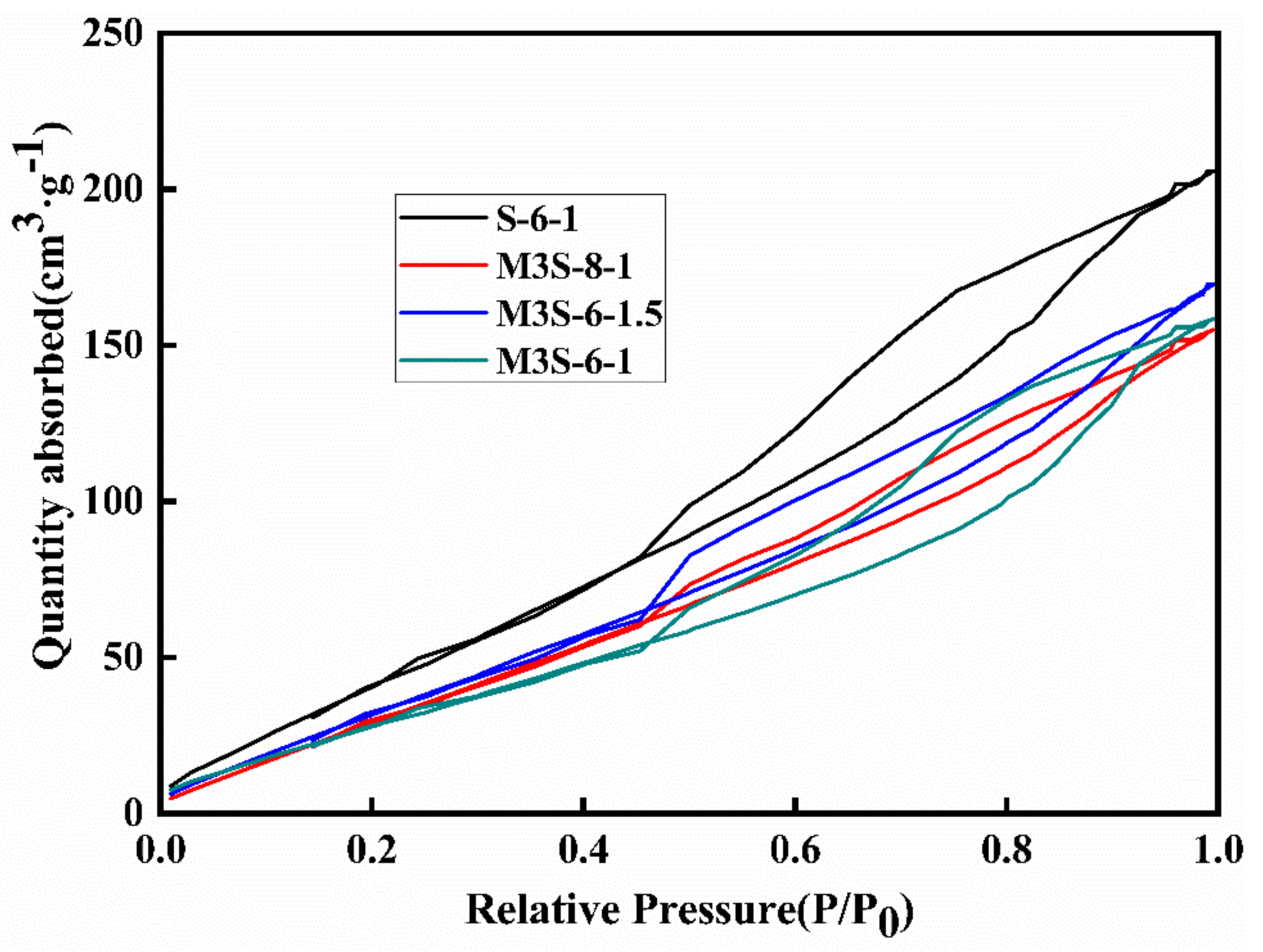

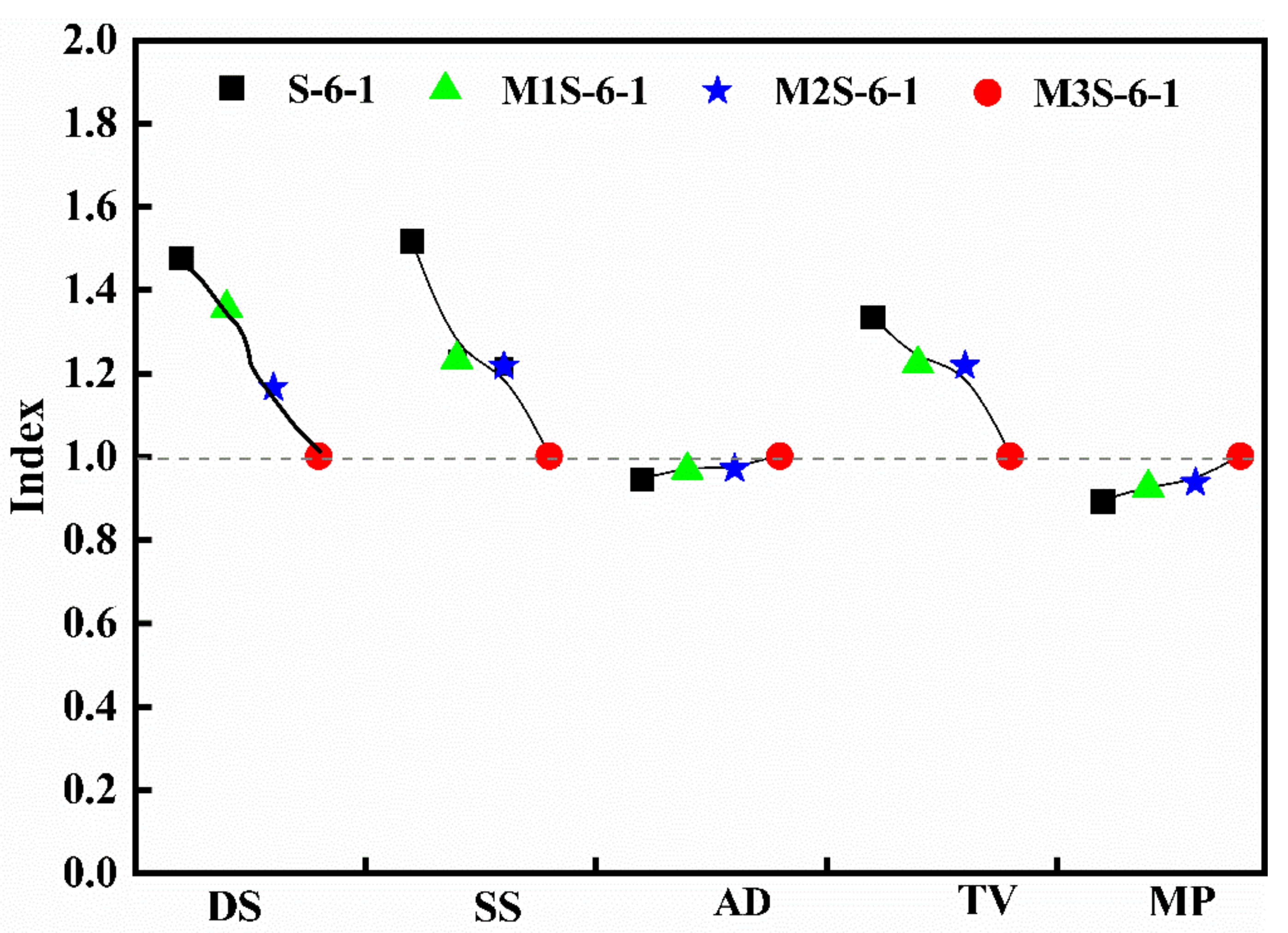
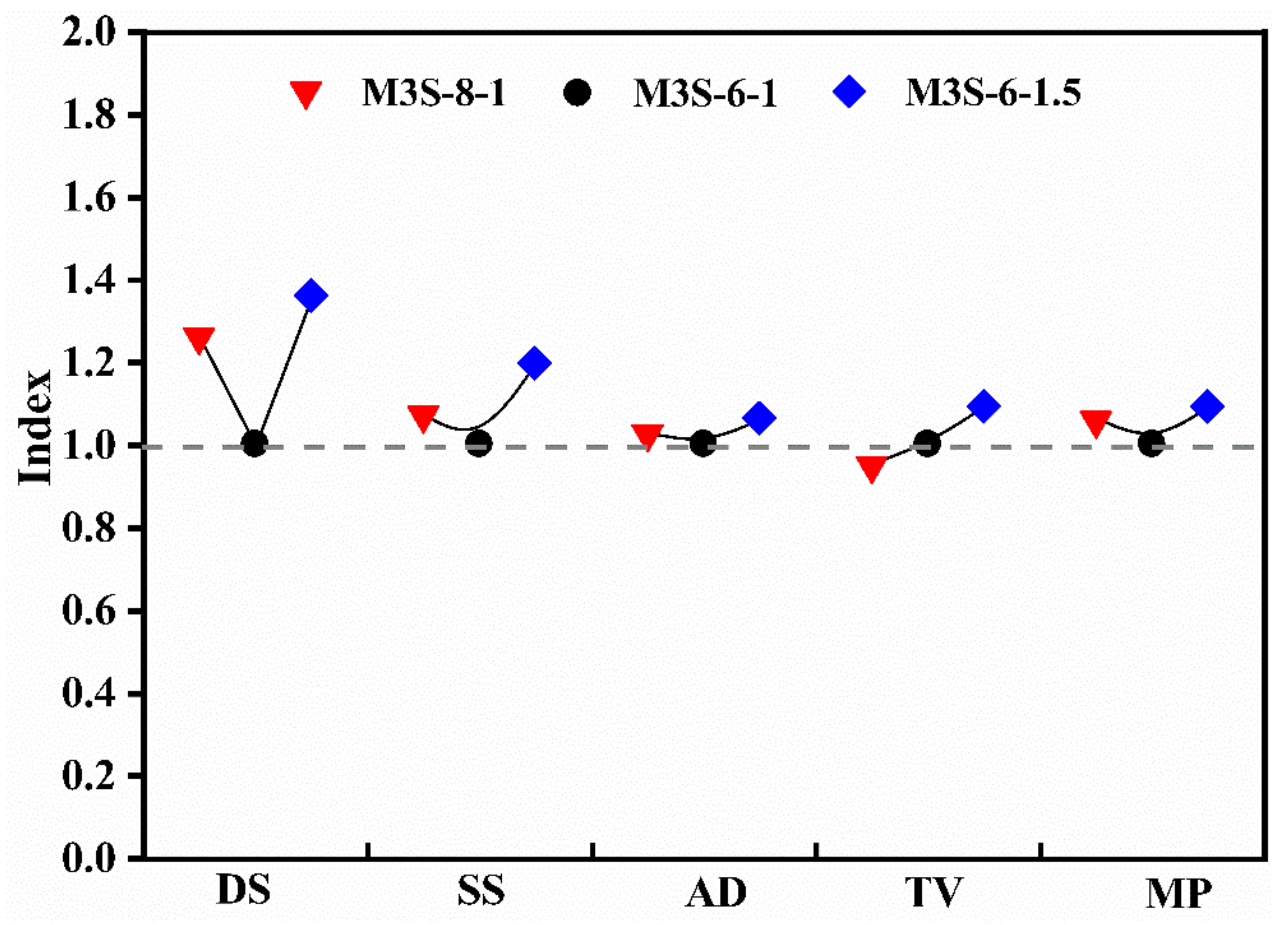
| K2O | Na2O | SO3 | SiO2 | Fe2O3 | Al2O3 | CaO | MgO | TiO2 | LOI | |
|---|---|---|---|---|---|---|---|---|---|---|
| Slag | 0.83 | 0.73 | 0.13 | 35.88 | 0.46 | 10.65 | 33.54 | 11.43 | 1.14 | 1.3 |
| Metakaolin | 0.44 | 0.41 | - | 49.78 | 0.93 | 34.63 | - | 2.58 | 1.01 | 1.1 |
| Paste Sample | ||||||
| No. | Slag (wt.%) | Metakaolin (wt.%) | Modulus of Activator | Na2O (%) | W/B Ratio | |
| S-6-1 | 100 | 0 | 1 | 6 | 0.4 | |
| M1S-6-1 | 90 | 10 | ||||
| M2S-6-1 | 80 | 20 | ||||
| M3S-6-1 | 70 | 30 | ||||
| M3S-8-1 | 70 | 30 | 1 | 8 | ||
| M3S-6-1.5 | 70 | 30 | 1.5 | 6 | ||
| Mortar Sample | ||||||
| No. | Slag (wt.%) | Metakaolin (wt.%) | Fine Aggregate (wt.%) | Modulus of Activator | Na2O (%) | W/B Ratio |
| S-6-1 | 33.33 | 0 | 66.67 | 1 | 6 | 0.45 |
| M1S-6-1 | 29.667 | 3.333 | 66.67 | |||
| M2S-6-1 | 26.664 | 6.666 | 66.67 | |||
| M3S-6-1 | 23.331 | 9.999 | 66.67 | |||
| M3S-8-1 | 23.331 | 9.999 | 66.67 | 1 | 8 | |
| M3S-6-1.5 | 23.331 | 9.999 | 66.67 | 1.5 | 6 | |
Publisher’s Note: MDPI stays neutral with regard to jurisdictional claims in published maps and institutional affiliations. |
© 2021 by the authors. Licensee MDPI, Basel, Switzerland. This article is an open access article distributed under the terms and conditions of the Creative Commons Attribution (CC BY) license (https://creativecommons.org/licenses/by/4.0/).
Share and Cite
Fu, B.; Cheng, Z.; Han, J.; Li, N. Understanding the Role of Metakaolin towards Mitigating the Shrinkage Behavior of Alkali-Activated Slag. Materials 2021, 14, 6962. https://doi.org/10.3390/ma14226962
Fu B, Cheng Z, Han J, Li N. Understanding the Role of Metakaolin towards Mitigating the Shrinkage Behavior of Alkali-Activated Slag. Materials. 2021; 14(22):6962. https://doi.org/10.3390/ma14226962
Chicago/Turabian StyleFu, Bo, Zhenyun Cheng, Jingyun Han, and Ning Li. 2021. "Understanding the Role of Metakaolin towards Mitigating the Shrinkage Behavior of Alkali-Activated Slag" Materials 14, no. 22: 6962. https://doi.org/10.3390/ma14226962
APA StyleFu, B., Cheng, Z., Han, J., & Li, N. (2021). Understanding the Role of Metakaolin towards Mitigating the Shrinkage Behavior of Alkali-Activated Slag. Materials, 14(22), 6962. https://doi.org/10.3390/ma14226962







